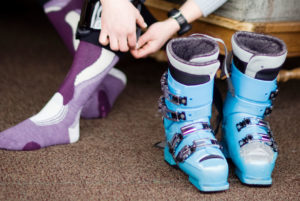
So, you bit the bullet with some new technical clothing! The higher price tag on waterproof, breathable, moisture wicking and wind blocking clothing will be well worth the investment and deliver for years with proper care. Read on to learn more about how to care for your sweet new ski parka…
Basic Care For Technical Fabrics
- Above all, always refer to the manufacture’s label in the garment. A warranty would be invalid should something happen to your dope new jacket with improper cleaning. Some outerwear also might come with additional care instructions on the hang tag.
- Many manufactures approve the use of cleaning and care products like Granger’s, Nikwax and Sport-Wash. Such products leave no residue and rinse cleanly. You can always call customer service for a particular brand to verify which cleaning products they recommend.
- Before washing, close zippers, seal velcro and turn article inside out. Front loading washing machines are best for washing outerwear so as to reduce the likelihood of abrasion and excessive twisting (diminishing the cleaning effectiveness).
- Heavily soiled items should aways be washed separately. Soil particles break into smaller pieces and could dirty other garments.
- Oil stains on synthetic materials like nylon or polyester should be treated as quickly as possible to minimize staining. Treat the stain with an approved stain remover. If stain remains after washing, do not dry the garment. If you are in the lodge, away from your trusty stain remover, blot the stain with water and ice.
- Never use fabric softeners on performance or technical fabrics. They break down the technical properties of the garment diminishing water repellency, breathability and wicking ability.
- Use powdered detergent.
Down Jacket Care
Many people prefer to have a down jacket cleaned by professionals since it’s somewhat of a task. Never dry clean down. If you’d like to launder down at home, fill a front loading washing machine with warm water. Add the jacket and allow it to wash in plain water, so that dirt and debris are safely removed. When cycle is complete, remove garment and hand squeeze any remaining water. Fill the washing machine with warm water again and run cycle with a gentle down safe detergent (refer to manufacture for recommendations) so as not to break down the feathers. When cycle is complete, squeeze out excess water, then lay jacket flat and blot with a dry towel to remove as much moisture as possible. Dry the garment on low for 15 minutes, then remove and fluff with your hands, so feathers remain evenly spread throughout. Tennis balls can be added to the dryer to aid in ‘refluffing’ the feathers. Return garment to dryer for another 15 minutes on low and repeat until nearly dry.
Fleece Care
First off, fleece is very heat sensitive, so never dry your fleece on high or iron it. Fleece should be washed inside out to avoid pilling in lukewarm water with a mild powdered detergent. Hang to dry or dry on low.
Softshell Jacket Care
Softshells can be machine washed with either warm or cold water using powdered laundry detergent that contains no fabric softeners. As mentioned earlier, washing reactivates the DWR treatment, so don’t be scared to wash your softshell jacket or pants! Additionally, soft shells breath better when clean. Tumble dry on low for 15-20 minutes or line dry. Never iron your soft-shell.
Always remove faux fur trim. Most are attached with buttons or a zipper.
Rainwear or Waterproof/Breathable Care
Regular cleaning of your rainwear allows it to preform at your best. How often it should be cleansed depends on how often you wear it. For Portland and Seattle residents, you may need to wash it once a month. As a generally rule of thumb, wash your rainwear at least once a year. Washings enhance breathability and reactivate DWR (water repellency coating). Over time however, say after a dozen washings, the DWR can loose it’s effectiveness and an approved waterproof spray should be applied. Like all other outerwear, close the zippers, turn the garment inside out, use a front loading washing machine with powdered detergent and treat stains immediately with cold water then a stain remover. Let the water and detergent mix before placing the garment inside. Two rinses are recommended to remove all residue. Dry on low for 15-20 minutes, then hang dry if still damp.
DWR (Durable Water Repellent) Care
Many people are pleasantly surprised to learn that DWR actually reactivates with each washing and drying. Removing dirt, oil and debris helps to expose the DWR, thereby making it more effective. Low heat for 15-20 minutes reactivates DWR effectiveness. Of course, after a dozen or so washings, DWR will break down. If at that time, you notice that water is no longer beading off the surface of the fabric, it’s a good time to apply a DWR finish from Granger’s, Nikwax, Sport-Wash or ReviveX.
Synthetic Base Layer Care
Synthetic base layers can certainly be washed with your regular clothing. However, it is strongly advised to use mild detergents that advertise as being “free” or “clear” from fragrances or excessive cleaning agents. Eco-friendly and biodegradable detergents tend to be far less harsh than low priced “regular” detergents. Be sure to use only the recommend amount of detergent, if not slightly less. Excess soap may leave a residue behind on the garment, thereby reducing it’s wicking and breathability properties. Since base layers can be vulnerable to snagging, do not wash with anything containing zippers or velcro. Wash with cool or warm water and dry on low for 15-20 minutes or line dry. Never use fabric softeners or bleach.
Wool Care
The biggest concern with wool is shrinkage. To be on the safe side, lay wool garments flat or hang to dry. Socks, however, can be dried with regular laundry on low as most wools sock manufacturers today have agreed. Like synthetic base layers, wool is also susceptible to snagging, so avoid washing with other garments with velcro, zippers or buttons. Stick to washing wool with knits.
Gore-Tex Maintenance
A full Gore-Tex manual on how to wash, treat and take care of this material.









